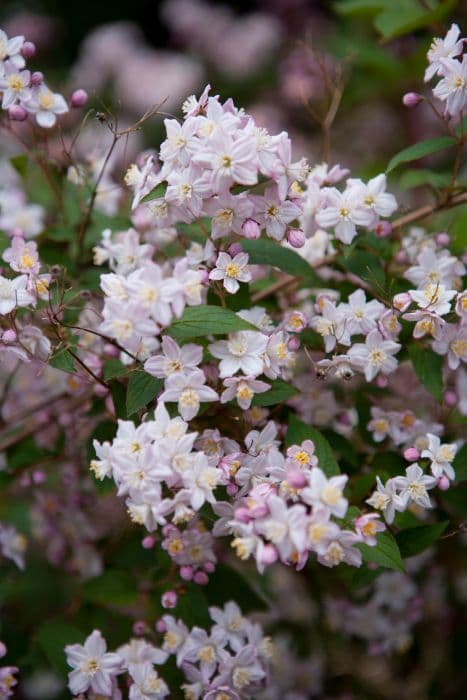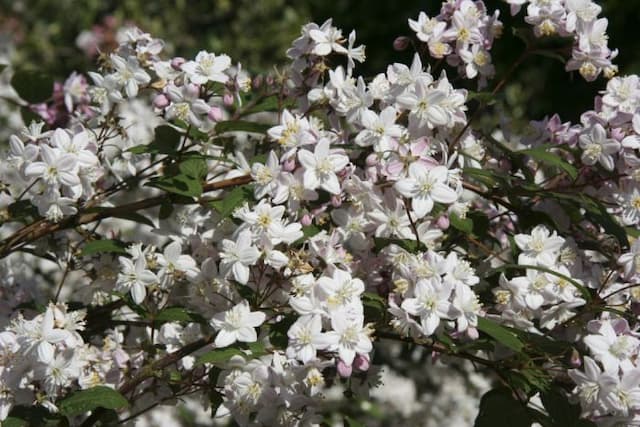PeeGee Hydrangea Hydrangea paniculata 'Grandiflora'

ABOUT
The Hydrangea paniculata 'Grandiflora', commonly known as PeeGee hydrangea, is a plant renowned for its spectacular display of large, showy flowers. Its appearance is characterized by a profusion of white blooms that tend to take on a pinkish hue as they age. These flowers are borne in cone-shaped clusters, also referred to as panicles, which can be quite dense and large, contributing to the plant's visual impact. The leaves of the PeeGee hydrangea are deep green, providing a lush backdrop for the floral display. Each leaf has a broad, oval shape with a pointed tip, and the edges are finely serrated. The foliage adds to the overall texture of the shrub and complements the flowers, especially when the plant is in full bloom. The stems of the PeeGee hydrangea are sturdy and woody, supporting the weight of the flower clusters. The bark appears as a muted brown color that contrasts nicely with the green leaves and the white to pink flowers. The PeeGee hydrangea's branches contribute to its rounded, bushy overall shape, with each branch potentially covered in flowers during the peak blooming season. Overall, the PeeGee hydrangea presents a visually pleasing aesthetic with its bountiful blooms and vibrant green foliage, making it a popular choice for gardeners seeking to add a striking ornamental feature to their landscapes.
About this plant
 Names
NamesFamily
Hydrangeaceae.
Synonyms
PeeGee Hydrangea, Panicle Hydrangea, Grandiflora.
Common names
Hydrangea paniculata 'Grandiflora'.
 Characteristics
CharacteristicsLife cycle
Perennials
Foliage type
Deciduous
Color of leaves
Green
Flower color
White
Height
10 feet [3 meters]
Spread
10 feet [3 meters]
Plant type
Shrub
Hardiness zones
3
Native area
China
Benefits
 General Benefits
General Benefits- Aesthetic Appeal: Hydrangea paniculata 'Grandiflora', commonly known as Peegee Hydrangea, produces large, showy flowers that enhance the visual appeal of gardens and landscapes.
- Seasonal Interest: The plant offers a prolonged blooming period from mid-summer to fall, providing interest throughout the seasons.
- Ease of Cultivation: Peegee Hydrangea is known for its hardiness and adaptability, making it an easy shrub to grow for gardeners of all skill levels.
- Wildlife Attraction: The flowers attract pollinators such as bees and butterflies, promoting biodiversity within the garden ecosystem.
- Versatility in Landscaping: This hydrangea can be used in various landscape designs, including as a specimen plant, in group plantings, or as a hedge.
- Drought Tolerance: Once established, Peegee Hydrangea has good drought tolerance, requiring less water than some other garden plants.
- Soil Adaptability: It can tolerate a wide range of soil types, although it prefers well-drained, moist soil with good fertility.
- Winter Interest: After the leaves fall, the dried flower heads continue to provide visual interest throughout the winter.
 Medical Properties
Medical PropertiesThis plant is not used for medical purposes.
 Air-purifying Qualities
Air-purifying QualitiesThis plant is not specifically known for air purifying qualities.
 Other Uses
Other Uses- Peegee hydrangea dried flower arrangements: The large, showy flowers of the Peegee hydrangea can be dried and used in floral arrangements for long-lasting decoration.
- Garden sculpting: Peegee hydrangea can be pruned into various shapes and sizes for garden design and topiary art.
- Photography prop: The lush blooms provide a beautiful backdrop for garden photography and portraiture.
- Wedding decor: Fresh or dried Peegee hydrangea flowers are often incorporated into wedding bouquets, centerpieces, and venue decorations.
- Craft projects: The flowers and woody stems can be used in handmade wreaths, garlands, or other craft items.
- Color-changing experiments: Adding aluminum sulfate to the soil can turn the flowers from white to pink or blue, making for interesting gardening experiments.
- Educational tool: Peegee hydrangea can be used to teach about soil pH and its effects on plant coloration.
- Shelter for wildlife: The dense foliage can provide shelter and nesting spots for birds and other small wildlife.
- Natural fencing: With its large size, Peegee hydrangea can be planted in rows to create a visual barrier or privacy hedge.
- Culinary presentations: Peegee hydrangea's striking blooms can be used as non-toxic decorative elements for plating and presenting high-end dishes in restaurants.
Interesting Facts
 Feng Shui
Feng ShuiThe Peegee Hydrangea is not used in Feng Shui practice.
 Zodiac Sign Compitability
Zodiac Sign CompitabilityThe Peegee Hydrangea is not used in astrology practice.
 Plant Symbolism
Plant Symbolism- Heartfelt and Sincere Emotions: The Hydrangea paniculata 'Grandiflora', commonly known as PeeGee Hydrangea, often symbolizes deep-rooted and genuine feelings due to its lush and abundant flower clusters.
- Vanity or Boastfulness: In some contexts, the peegee hydrangea can signify vanity or boastfulness, possibly stemming from its large, showy blossoms.
- Gratitude: The peegee hydrangea is also a symbol of thankfulness and is often given as a gift to express appreciation.
- Understanding: The diversity of colors and shapes in peegee hydrangea blooms can represent comprehension and a willingness to understand someone else's perspective.
- Abundance: With its full, bountiful blooms, the peegee hydrangea can symbolize abundance or prosperity.
- Frigidity or Lack of Emotion: In some traditional flower language, hydrangeas can also represent disinterest or coldness of emotion, though this meaning is less commonly attributed to the peegee hydrangea specifically.
 Water
WaterPeegee hydrangeas should be watered deeply, ensuring the soil is moist but not soggy. During the active growing season in spring and summer, water the plant once or twice a week, depending on the weather and soil conditions. Each watering should consist of about 1 inch of water, equivalent to approximately 0.6 gallons for a small shrub. Reduce the frequency to every other week in the fall, and during winter, only water if the soil is dry and the plant is not dormant. Overwatering can lead to root rot, so it's important to allow the soil to dry slightly between waterings.
 Light
LightPeegee hydrangeas prefer full sun to partial shade, requiring at least 4 hours of direct sunlight daily for optimal blooming. A spot that offers morning sunlight with some afternoon shade can help protect the blooms from intense afternoon heat. Avoid deep shade, as it can reduce flowering and weaken the plant.
 Temperature
TemperaturePeegee hydrangeas thrive in a wide range of temperatures, but they perform best when daytime temperatures are between 65°F and 75°F. They are hardy in USDA zones 3 through 8, tolerating winter temperatures down to -40°F and summer temperatures up to 95°F without significant stress.
 Pruning
PruningPruning peegee hydrangeas promotes healthy growth, encourages new blooms, and maintains desired shape. Prune in late winter or early spring before new growth begins, as flowers form on current year's growth. Remove about one-third of the oldest stems to rejuvenate the plant, and trim back any dead or crossing branches.
 Cleaning
CleaningAs needed
 Soil
SoilThe PeeGee hydrangea thrives in well-draining, fertile soil with a pH of 5.5 to 6.5. A mix of loamy garden soil, peat moss, and compost is ideal to provide a rich and aerated foundation. The soil should retain moisture but not become waterlogged to prevent root rot.
 Repotting
RepottingPeeGee hydrangeas grown in containers should be repotted every 2 to 3 years to ensure sufficient root space and nutrient availability. It's essential to use a larger container and fresh soil mix to encourage ongoing growth and blooming.
 Humidity & Misting
Humidity & MistingPeeGee hydrangeas prefer moderate humidity levels, avoiding extremes. Average room humidity around 50% is typically adequate. They can tolerate higher humidity outdoor environments well, especially if they have good air circulation.
 Suitable locations
Suitable locationsIndoor
Place in bright, indirect light with well-draining soil.
Outdoor
Plant in partial sun to full sun with moist, rich soil.
Hardiness zone
3-8 USDA
 Life cycle
Life cycleThe life cycle of the Hydrangea paniculata 'Grandiflora', or PeeGee Hydrangea, begins with seed germination, usually occurring in spring when temperatures moderate. After germination, the seedling enters a vegetative growth phase, developing roots and foliage as it matures into a flowering shrub over several months to years depending on conditions. The plant reaches maturity and enters the flowering stage typically in mid to late summer, producing large panicles of white flowers that may age to a pinkish hue. Following pollination, the flowers produce seeds by late summer or fall, which can be dispersed by wind or animals. During the autumn, the PeeGee Hydrangea enters a dormancy phase, with leaves turning yellow and dropping as the plant prepares for the winter. Finally, the cycle repeats itself in the spring, as new growth emerges from surviving stems and root systems, continuing the perennial life cycle of the plant.
 Propogation
PropogationPropogation time
Late winter - early spring
Hydrangea paniculata 'Grandiflora', commonly known as PeeGee Hydrangea, is most commonly propagated through softwood cuttings. This method is ideally performed in late spring to early summer. To propagate, a gardener would take a cutting from a healthy branch that has no flowers, typically about 4 to 6 inches (10 to 15 centimeters) long. The leaves on the lower half of the cutting are removed, and the cut end is often dipped in rooting hormone to encourage root development. The cutting is then planted in a moist potting mixture, and the environment is kept humid by covering the pot with a plastic bag or placing it in a propagation case. After a few weeks, roots will have developed, and the plastic can be gradually removed to acclimatize the new plant. With proper care, these cuttings can be transplanted into the garden once they have established a robust root system.








![Hydrangea [Early Sensation]](/_next/image?url=https%3A%2F%2Fplants-admin.emdemapps.com%2Fimages%2Fplants%2F%2Fimages%2F604b6150338db.png&w=640&q=75)
